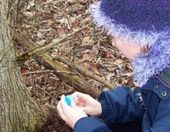
© Washington University
Washington University graduate student Kim Lorenz collects yeast samples from Pennsylvania oak trees as part of a project to analyze how genes interact to produce complex traits.
This disappointment has led geneticist Barak Cohen, Ph.D., of Washington University School of Medicine in St. Louis, to suggest that scientists need to get a better handle on the ways genes interact to influence disease risk.
"For diseases that are major health problems, many different genetic variants combine to affect an individual's risk," says Cohen. "The problem is that we as scientists are really lousy at predicting how these variations interact to determine whether an individual is likely to develop a common disease or respond to a particular drug."
This reality begs the question: Is it possible to tease apart a complex genetic trait to reveal the precise genetic variations that have combined to produce it? Yes, Cohen and his group report in the Jan. 23 issue of
Science. If the research can be replicated, it suggests that scientists need better statistical models and other tools to understand genetic interactions.

Comment: Don't worry about the mercury in vaccines. Don't worry about the toxins in what they want us to call food. Don't worry about the poisons in our water, soft drinks, and the list goes on.
Blame the smokers.